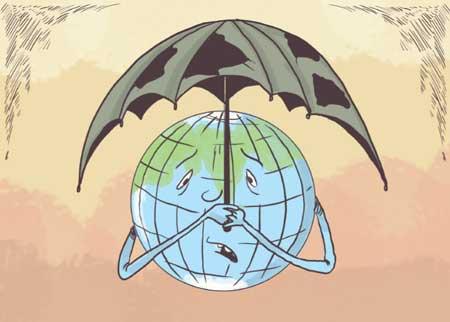24 Sep 2022 - {{hitsCtrl.values.hits}}
Despite the worst socio-economic and political crisis since independence, Sri Lanka is still a beautiful island in the sun. As one of history’s best Afro-American popstars Harry Belafonte sings : “This is my island in the sun, where my people have toiled since time begun, I may sail on many a sea, her shores will always be home to me; oh, island in the sun, willed to me by my father’s hand, all my days I will sing in praise, of your forests, waters, your shining sand.”
 Besides the socio-economic crisis where millions of people are finding it difficult to obtain shelter, food, healthcare and clothing, Sri Lanka also needs to give attention to the battle against climate change and especially the preservation of the ozone layer.
Besides the socio-economic crisis where millions of people are finding it difficult to obtain shelter, food, healthcare and clothing, Sri Lanka also needs to give attention to the battle against climate change and especially the preservation of the ozone layer.
Earlier this month the UN marked the International Day for the Preservation of the Ozone Layer, highlighting the need for global cooperation to protect life on earth. In a statement, the UN says the ozone layer--a fragile shield of gas--protects the Earth from the harmful portion of the rays of the sun, thus helping preserve life on the planet. The phaseout of controlled uses of ozone depleting substances and the related reductions have not only helped protect the ozone layer for this and future generations, but have also contributed significantly to global efforts to address climate change. Furthermore, it has protected human health and ecosystems by limiting the harmful ultraviolet radiation from reaching the Earth.
According to the UN as the Montreal Protocol turns 35 on Ozone Day, we will remember how it ended one of the biggest threats ever to face humanity as a whole: the depletion of the ozone layer- When the world found out that ozone-depleting gases used in aerosols and cooling were creating a hole in the sky, it came together. They showed that multilateralism and effective global cooperation worked and they phased out these gases.
Now the ozone layer is healing, allowing it once again to shield humanity from the sun’s ultraviolet radiation. A number of commonly used chemicals have been found to be extremely damaging to the ozone layer. Halocarbons are chemicals in which one or more carbon atoms are linked to one or more halogen atoms--fluorine, chlorine, bromine or iodine. Halocarbons containing bromine usually have much higher ozone-depleting potential (ODP) than those containing chlorine. The man-made chemicals that have provided most of the chlorine and bromine for ozone depletion are methyl bromide, methyl chloroform, carbon tetrachloride and families of chemicals known as halons, chlorofluorocarbons (CFCs) and hydrochlorofluorocarbons (HCFCs).
The scientific confirmation of the depletion of the ozone layer prompted the international community to establish a mechanism for cooperation to take action to protect the ozone layer. This was formalized in the Vienna Convention for the Protection of the Ozone Layer. This was adopted and signed by 28 countries, on March 22, 1985. In September 1987, this led to the drafting of The Montreal Protocol on Substances that Deplete the Ozone Layer.
The Montreal Protocol’s principal aim is to protect the ozone layer by taking measures to control total global production and consumption of substances that deplete it, with the ultimate objective of their elimination on the basis of developments in scientific knowledge and technological information. It is structured around several groups of ozone-depleting substances. The groups of chemicals are classified according to the chemical family and are listed in annexes to the Montreal Protocol text. The Protocol requires the control of about 100 chemicals, in several categories. For each group or annex of chemicals, the Treaty sets out a timetable for the phase-out of production and consumption of those substances, with the aim of eventually eliminating them completely.
The UN says the timetable set by the Protocol applies to consumption of ozone depleting substances.
Consumption is defined as the quantities produced plus imported, less those quantities exported in any given year. There is also a deduction for verified destruction. Percentage reductions relate to the designated base-line year for the substance. The Protocol does not forbid the use of existing or recycled controlled substances beyond the phase-out dates. As the world’s most admired statesperson Mahatma Gandhi says, “The earth provides enough to satisfy every persons ‘s need, but not every persons’ greed.”
10 Jan 2025 2 hours ago
10 Jan 2025 2 hours ago
10 Jan 2025 3 hours ago
10 Jan 2025 4 hours ago
10 Jan 2025 4 hours ago